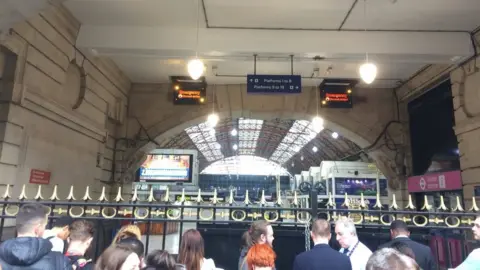Flying Scotsman steam sets off London Victoria fire alarm
 BBC
BBCRush hour commuters had to clear a busy London railway station after steam from the Flying Scotsman set off the fire alarm.
The world's best known steam engine sparked the evacuation when it arrived at London Victoria at about 19:00 BST.
BBC reporter Henry Monk said no-one panicked and everyone left calmly - apart from one man who ran out quickly.
Network Rail confirmed that "steam and smoke" from the locomotive set off the station's fire alarm.
A spokesperson said the alarm led to "the short evacuation of the station for 15 minutes" from 19:21 to 19:36.
 Graham Eva
Graham EvaThe BBC understands fire alarms are normally switched off when the steam engine pays a visit to the central London terminus.
But station staff told Mr Monk that on Thursday the warning was not given and the locomotive's huge cloud of steam sparked an alert.

You may also like:

Commuters were initially left perplexed after hearing warnings of disruption from rail operator Southeastern.
Allow X content?
Southeastern later posted an update which said: "The cause of the fire alarm at Victoria has been found (the steam train there set them off). The station will re open shortly and trains will commence running."
After hearing why the alarms had gone off, passenger Simon Trewin tweeted to say it was the "best excuse EVER".
Allow X content?
The Flying Scotsman is visiting towns and cities across the UK as part of a summer tour.
It comes after The National Railway Museum, which owns the locomotive, signed a six-year deal with engineering firm Riley & Son (E) Ltd.
